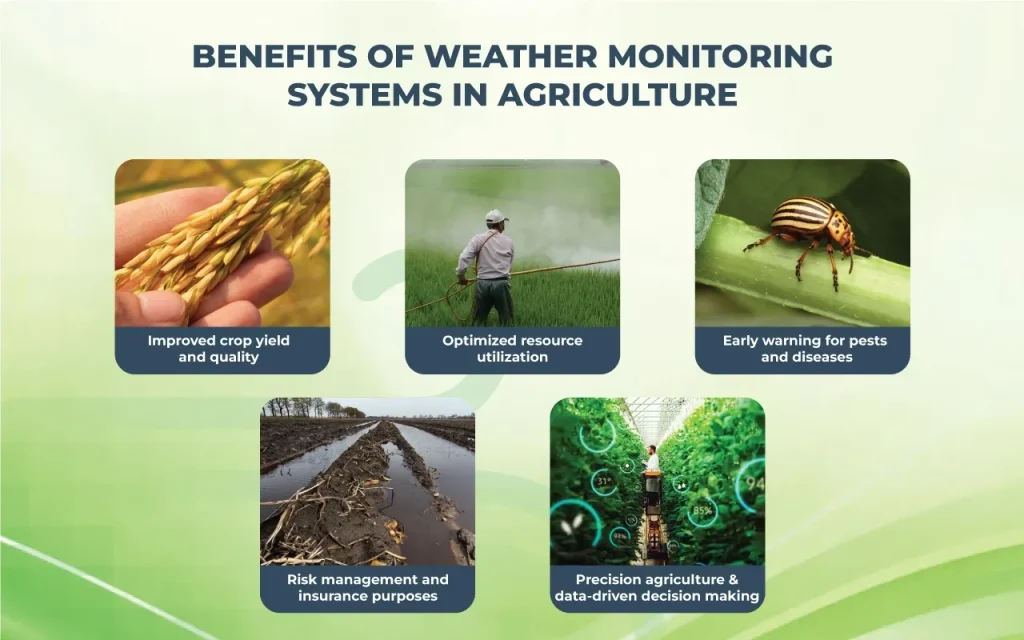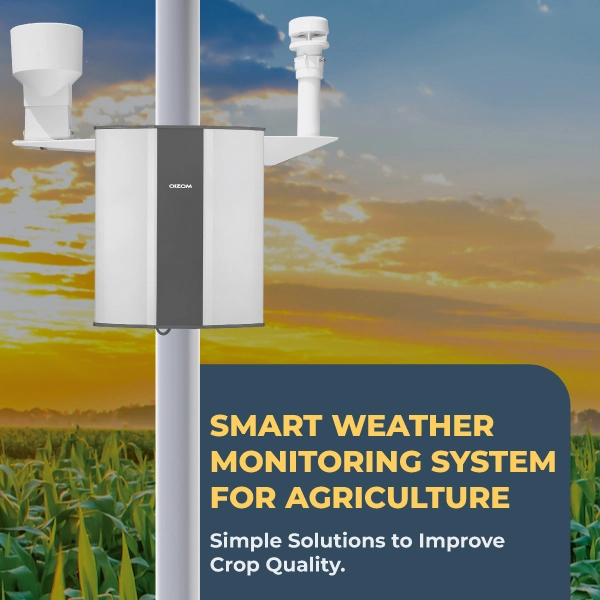Key Takeaway Points:
- Weather Monitoring Systems: These systems provide real-time data on weather conditions, helping farmers make informed decisions to improve crop yields and protect their investments.
- Importance of Weather in Agriculture: Weather conditions directly affect crop health, growth, and yield, making accurate weather prediction essential for successful farming.
- Challenges of Unpredictable Weather: Irregular weather patterns, such as droughts and sudden heavy rains, pose significant crop risks, leading to potential losses.
- Benefits of Weather Monitoring: Precise data from weather stations help optimize farming activities like sowing, irrigation, and pesticide application, leading to better resource efficiency.
- Improved Crop Yield: Real-time weather data allows farmers to predict the best times for sowing and harvesting, enhancing crop quality and yield.
- Optimized Resource Use: Accurate weather data helps reduce water, fertilizers, and pesticide waste by tailoring usage to actual crop needs, reducing environmental impact.
- Early Pest and Disease Warnings: Monitoring weather conditions like humidity and temperature enables farmers to anticipate and prevent pest and disease outbreaks.
- Risk Management: Weather monitoring supports agricultural risk mitigation and provides data for validating insurance claims related to weather-induced crop damage.
- Precision Agriculture: Data-driven decision-making through weather monitoring allows for better crop planning and resource allocation, improving overall farm efficiency.
- Sustainable Farming: By adopting advanced weather monitoring systems, farmers can enhance productivity, reduce costs, and contribute to a more sustainable agricultural future.
Smart Weather Monitoring System for Agriculture: Simple Solutions to Improve Crop Quality.
In today’s world, Agricultural development has always been linked to weather interpretation and prediction. Farming is both an art and a science, so having the right tools can make all the difference. The first regular rain gauge was invented in 1441, and since then, humanity has tried to better predict the weather by using more advanced tools to protect their crops. To bridge the gap between this, researchers have invented one of the most powerful tools, a weather monitoring system. These systems provide real-time data on weather conditions, helping farmers make informed decisions that can boost crop yields and protect their investments.
Whether it’s tracking rainfall, temperature, or humidity, a weather monitoring system can offer precise insights tailored to a specific location. Farmers can plan their planting, irrigation, and harvesting schedules more effectively, reducing risks and optimizing resources. With technology like this, agriculture becomes more efficient and sustainable, helping farmers adapt to the ever-changing climate conditions. So, whether you’re managing a large farm or a small plot, understanding how a weather monitoring system works could be your key to success. This article will discuss the importance of weather monitoring in agriculture, its benefits, and the challenges farmers face due to unpredictable weather.
Importance of weather in agriculture
Most crops cultivated in fields rely only on rain and sunshine for survival. Meteorological conditions impact the health and availability of food.
- Severe weather can cause harmful agricultural losses. High temperatures, limited rainfall, flooding, and rapid freezes severely impact crops, especially at the most vulnerable periods of plant growth, such as seed germination. Studies have shown that dryness is often a primary cause of decreasing grain yields and farm economic losses.
- Weather indirectly affects crops through alterations in soil processes, nitrogen uptake dynamics, and pest population expansion. The indirect impact of weather on agriculture includes soil erosion and nutrient shortage caused by heavy rain, as well as soil salinization during a dry spell.
Challenges faced by farmers due to unpredictable weather
Farmers rely on good weather to grow their food; too much rain causes rotting plants, while insufficient rainfall makes it difficult to cultivate crops and feed animals. Too much wind can make planting difficult while freezing conditions might inhibit plant growth.
- Let me explain to you through a good example; imagine this: once a farmer who, every morning, knew exactly what the day would bring. Rainfall patterns were reliable and familiar, like old friends. He was aware of when to plant his maize, tend to his tomatoes, and harvest his crops. However, the weather has recently become a terrible beast.
- Droughts, which were formerly uncommon, have returned to his property, scorching the ground and leaving his crops seeking water. When the rare and precious precipitation does fall, it frequently comes in short, rapid bursts that destroy important topsoil and saturate crops. Like millions of farmers worldwide, it is becoming increasingly challenging due to this irregular weather.
- The most immediate challenge is water. With rising temperatures, evaporation rates increase, resulting in less water in the soil. Droughts, once a rare event, are becoming more frequent and severe; a drought is the absence of precipitation, such as rain or snow.
- Farmers require water to maintain healthy soil and develop plants, and rain is an important water supplier. During a drought, many crops perish. The other side of the coin is unexpected bursts of severe rain. These quick surges can trigger severe flooding, sweeping through crops and removing valuable topsoil with nutrients.
Benefits of Weather Monitoring Systems in agriculture

Weather stations in agriculture offer valuable benefits by providing precise data and actionable insights for better farm management. They help farmers monitor local climate conditions, optimize activities like sowing, irrigation, and pesticide application, and improve resource efficiency in water and energy use. This leads to better crop management and more accurate yield predictions, ultimately enhancing sustainability.
Improved crop yield and quality
An accurate weather monitoring system from agriculture sites enables an extensive understanding of microclimatic conditions on a farm. This level of precision is critical for predicting the best times to sow and harvest, which are greatly impacted by meteorological conditions. For example, farmers can avoid frost damage by delaying planting during low temperatures. Similarly, understanding the precise moisture conditions aids in deciding the ideal time to harvest, especially for moisture-sensitive crops such as grains, where too much moisture during harvest can lead to spoiling. Furthermore, real-time weather data aids in forecasting potential pest and disease outbreaks, which are frequently weather-related.
This predictive capability enables farmers to apply treatments only when necessary, improving crop health and yield outcomes. Farmers can also use weather station data to update their crop models and develop more accurate yield projections, which are necessary for effectively planning and marketing their crops.
Optimized resource utilization (water, fertilizers, pesticides)
One of the most important benefits of employing weather monitoring systems in agriculture is the possible reduction in resource waste. Accurate and localized weather data enables farmers to use water more efficiently by customizing irrigation schedules to the crops’ actual demands depending on current weather conditions and soil moisture levels. This conserves water and reduces the energy required to pump and distribute water, minimizing the carbon footprint of farming operations.
Similarly, detailed weather monitoring enables the specific operations of fertilizers. Farmers can reduce fertilizer consumption by recognizing the varied demands of crops at different growth stages and under different weather circumstances, decreasing runoff and the risk of environmental damage. This focused strategy reduces expenses and promotes better soil and ecosystems.
Early warning for pests and diseases
Pests grow in high humidity and warmer temperatures, leading to crop diseases. Monitoring these indicators allows farmers to determine the risk of pest and disease outbreaks and safeguard their crops accordingly.
Farmers can improve crop management and reduce weather-related damage by measuring and analyzing all these conditions.
Risk management and insurance purposes
Weather monitoring systems are important in agricultural risk mitigation and insurance claims. By delivering real-time data on numerous meteorological aspects, these technologies help farmers make informed decisions and safeguard their crops.
- Claim Validation: Weather monitoring systems can provide objective evidence to support insurance claims. Farmers can use the data collected by these systems to substantiate their claims and expedite the insurance process in the event of crop damage due to adverse weather conditions.
- Weather data can help insurance companies estimate risk and set suitable premiums. By studying historical weather patterns and present conditions, insurers can modify premiums to reflect the unique risks faced by different regions and crops.
Precision agriculture and data-driven decision making
By collecting and processing data obtained through smart weather monitoring, farmers can predict the future state of soils and ecosystems and plan crops for the following year. Thus, predictive analytics enables them to make informed agriculture management decisions and plan for the future.
Conclusion
Concerns about climate change and its impact on agriculture have encouraged the development of precision and smart farming practices. These methods are based on cutting-edge technology, such as IoT weather monitoring systems, satellite remote sensing, artificial intelligence, and machine learning. As the backbone of modern precision agriculture, these instruments give more than simply data; they pave the road for improved decision-making, which can greatly increase farming operations’ efficiency, production, and sustainability.
By monitoring temperature, humidity, rain, soil moisture, and other parameters with Weathercom at agricultural sites, farmers can get accurate data on a real-time basis, helping them to make informed decisions about their crop quality and boost production. As a result, agribusinesses can reduce the adverse influence of weather, enhance farming and growing efficiency, and lower costs. By adopting our advanced weather stations, farms can not only stay competitive in a fast-evolving market but also contribute to a more sustainable agricultural future.
FAQs
A weather monitoring system provides real-time data on key environmental factors, helping farmers make informed decisions to improve crop management and yield.
Key parameters include temperature, humidity, rainfall, wind speed, and soil moisture, all crucial for effective farming practices.
Ut elit tellus, luctus nec ullamcorper mattis, pulvinar dapibus leo.
Common sensors measure temperature, humidity, rainfall, wind speed, and soil moisture.
Yes, even small-scale farmers can use weather monitoring to enhance decision-making, improve crop quality, and boost production.






